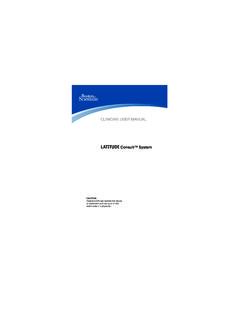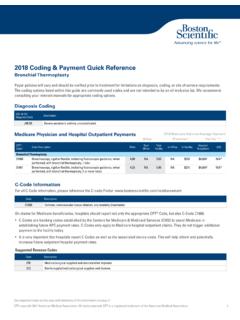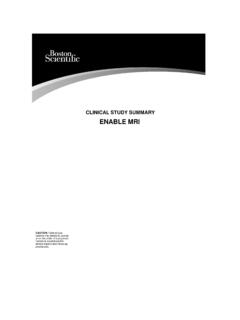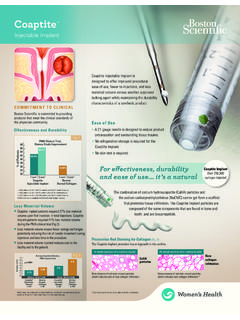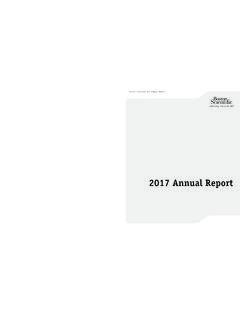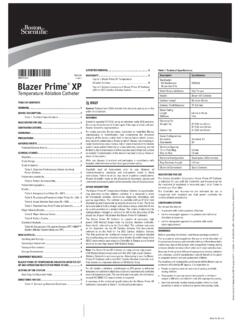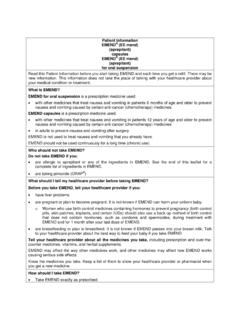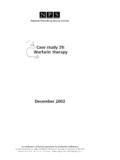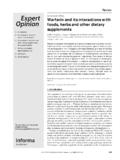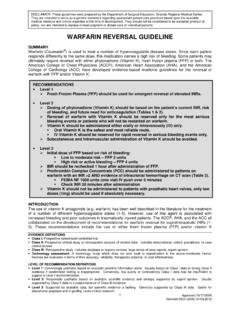Transcription of WATCHMAN Left Atrial Appendage Closure Device
1 Patient information GuideBoston Scienti c, (ePatient Guide (PG)Template, 8in x 8in, 90642526 AA), ePG, WATCHMAN , EN, 90743933-02 ABlack (K) E left Atrial Appendage Closure Device2 Boston Scienti c, (ePatient Guide (PG)Template, 8in x 8in, 90642526 AA), ePG, WATCHMAN , EN, 90743933-02 ABlack (K) E information GUIDEYour doctor has recommended that you consider undergoing a procedure to receive the WATCHMAN Implant or you have recently had a WATCHMAN Implant procedure in a part of your heart called the left Atrial Appendage (LAA). The following information about the WATCHMAN Implant is important for you to know and will address many of the common questions you may have about your YOUR HEARTThis section will discuss the basic function of the normal heart and will also explain what happens when the heart develops the condition known as Atrial Normal HeartThe heart is divided into four chambers: two upper Atrial chambers (a right and left atrium) and two lower ventricular chambers (a right and left ventricle).
2 The four chambers fill with blood when the heart is at rest and then pump the blood throughout the body with each heart beat (or contraction).The heart has specialized cells which produce electrical impulses that stimulate the heart muscle cells to beat and pump blood. Normally, your heart s pumping rate is controlled by the heart s internal pacemaker that is located in the upper portion of the right atrium. The heart beat spreads throughout both the right atrium and left atrium and then travels through special pathways to both the right and left ventricles. This electrical stimulation causes the heart muscle to contract and pump blood through the blood vessels. The heart then rests and fills with blood until the next contraction occurs.
3 This cycle occurs millions of times in a FibrillationIn Atrial fibrillation, the right and left atria no longer contract together in a coordinated fashion and the heart beat (pulse) becomes irregular. Atrial fibrillation can cause you to have symptoms such as feeling tired (fatigue), lightheaded, short of breath, or have a fluttering sensation in your chest (palpitations). It is also possible that you may have no often prescribe medications to prevent the pulse rate from getting too fast. These medications typically help patients feel well and able to do normal activities despite having Atrial fibrillation. However, despite taking these medications (or trying these medications) some patients still feel poorly due to Atrial fibrillation and require additional medications or special heart procedures (known as cardioversion and ablation) to try to stop Atrial fibrillation altogether and keep the heart in a normal Fibrillation, Heart Blood Clots, and the Risk of StrokeBecause right and left atria no longer contract normally in Atrial fibrillation, the blood flow within the atria can be slower than normal.
4 This change in blood flow may also cause blood clots to form. During Atrial fibrillation, most blood clots that originate in the heart develop in the left Atrial Appendage , which is a pouch-like structure that is part of the left A triumLeft A trial Appendage withthe WATCHMAN ImplantLeft V entricleRight VentricleRight AtriumA blood clot is called a thrombus when it is stays in one place, and if it breaks loose and travels to another part of the body, it is then called a thromboembolus. A thromboembolus can be dangerous if it blocks a blood vessel that supplies blood to an important body part. If a thromboembolus breaks loose from the left Atrial Appendage and blocks a blood vessel in the brain, the part of the brain that is supplied by that blood vessel can become permanently damaged within minutes.
5 This type of brain damage is known as a stroke. A stroke can result in the loss of a body function, weakness, a change in sensation, problems speaking, or even death. Besides the brain, a thromboembolus can travel to other areas of the body and cause organ damage by blocking blood left Atrial Appendage Closure Device3 Boston Scienti c, (ePatient Guide (PG)Template, 8in x 8in, 90642526 AA), ePG, WATCHMAN , EN, 90743933-02 ABlack (K) E all Atrial fibrillation patients are at equal risk for developing left Atrial Appendage blood clots and stroke. Factors that increase the risk include advancing age (particularly ages greater than 75 years), high blood pressure, heart failure, diabetes, other cardiovascular (heart) disease, and a prior stroke or mini-stroke ( transient ischemic attack or TIA).
6 Current Treatment to Prevent Stroke in Atrial Fibrillation PatientsThe current treatment for Atrial fibrillation patients who are at increased risk for stroke is treatment with blood-thinning medications called anticoagulants, which reduce the chance that blood clots form. These medications (which include warfarin [commonly referred to as Coumadin ] and other newer approved anticoagulants) are very effective in lowering the risk of stroke in Atrial fibrillation patients . Most patients can safely take these medications for years (and even decades) without serious side , some patients find that anticoagulants can be difficult to tolerate or risky. Because they prevent blood clots by thinning the blood, anticoagulants can increase the risk of bleeding problems.
7 When bleeding events occur, the events are often minor (like a skin cut taking longer to stop bleeding than normal) and easily treated. But in some cases, bleeding can be quite serious requiring hospitalization and transfusion and can even be life-threatening or fatal (such as when strokes are caused by bleeding into the brain).When prescribing anticoagulant medications in Atrial fibrillation patients , doctors consider the risk of a stroke versus the risk of a serious bleeding problem. In studies of Atrial fibrillation patients , the benefit of a reduced risk of stroke caused by a blood clot traveling from the left Atrial Appendage is greater than the risk of major bleeding (including strokes caused by bleeding into the brain).
8 This means that more strokes are prevented by anticoagulant medications than are caused by anticoagulant medications. Therefore, anticoagulant medications are recommended for most patients . However, in select patients , the risk of major bleeding is believed to be too high, so that anticoagulants will not be prescribed. Other Atrial fibrillation patients , even though they may be able to take anticoagulant medications without major bleeding, may choose not to take the medication because of minor bleeding episodes, other medication side effects, or concerns about bleeding due to with the WATCHMAN Implant to Prevent Stroke in Atrial Fibrillation PatientsYour doctor has prescribed the WATCHMAN Implant for you because you have Atrial fibrillation without significant heart valve disease, but with other risk factors that put you at an increased risk of stroke.
9 Although you may take an anticoagulant (blood thinning medication) called warfarin to reduce the risk of stroke, your doctor has recommended that you undergo implantation of the WATCHMAN Implant as an alternative to long-term use of this drug. In making this recommendation, your doctor has considered the benefits and risks of the WATCHMAN Implant compared to the benefits and risks of warfarin and/or the benefits and risks of other approved anticoagulant medication that are used to reduce the risk of stroke in Atrial fibrillation patients . Among the factors you and your doctor may consider are your overall risk of stroke, your risk of stroke caused by a blockage of a blood vessel in the brain, and your risk of a major bleeding problem while taking anticoagulant medications (including bleeding in the brain).
10 In the case of preventing a stroke caused by a blockage of a blood vessel in the brain, anticoagulant medications may be better than the WATCHMAN Implant. On the other hand, anticoagulant medications increase the risk of major bleeding episodes (including bleeding in the brain), and anticoagulant medications can usually be stopped about 6 weeks after successful placement of the WATCHMAN Implant in your heart, provided the left Atrial Appendage has been adequately sealed. Your doctor will also consider your personal preferences regarding anticoagulant medications and heart procedures associated with implanting and monitoring the WATCHMAN a blood clot develops in the heart of a patient with Atrial fibrillation, it is most often found within the left Atrial Appendage .

